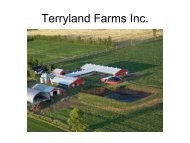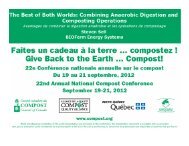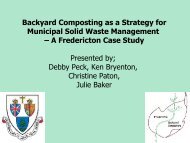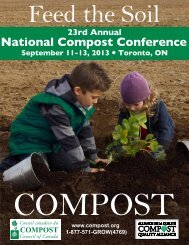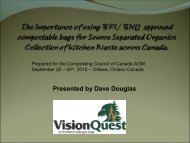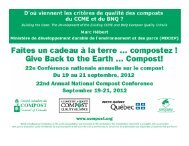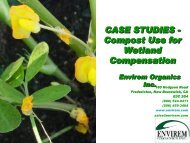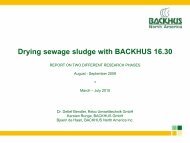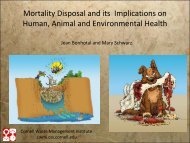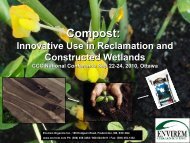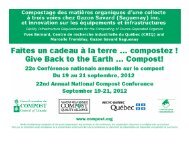Allan Yee, City of Edmonton - Compost Council of Canada
Allan Yee, City of Edmonton - Compost Council of Canada
Allan Yee, City of Edmonton - Compost Council of Canada
- No tags were found...
You also want an ePaper? Increase the reach of your titles
YUMPU automatically turns print PDFs into web optimized ePapers that Google loves.
OutlineBasic Conceptual and Technical BackgroundProtocols – uses, commonalities anddifferencesSimplified <strong>of</strong>fset calculation example<strong>City</strong> <strong>of</strong> <strong>Edmonton</strong> <strong>of</strong>fset calculation exampleCrystal BallingWaste Management Branch
The Concept <strong>of</strong> GHG OffsetsFormalization <strong>of</strong> GHG <strong>of</strong>fsets under 1997Kyoto Protocol – 2 market mechanisms: Clean Development Mechanism – rich nations“<strong>of</strong>fset” their emissions through investing in cleanenergy projects in developing world. Regulated domestic emitters (industries) have theirfree GHG emissions “capped”. Sale <strong>of</strong> surpluscredits, purchase <strong>of</strong> shortfall credits from regulatedor non-regulated industries/activities throughtrading.Waste Management Branch
Side note: Validation vs. VerificationValidation/verification guidelines follow fromthe ISO 14064-3: 2006 standard.Validation - the process <strong>of</strong> determining projecteligibility and focuses on whetherproject/baseline conditions and methodologyare appropriate.Verification - checks calculation correctnessand data integrity, consistency, completenessand accuracy.Waste Management Branch
ProtocolsProtocols are SOPs for ensuring all relevantmeasurement, monitoring and GHG quantificationelements (sources, sinks, reservoirs) associated with anon-regulated activity are considered in a completelife cycle analysis.Use <strong>of</strong> pre-approved protocols largely negates theneed for validation except for unique projects.Various jurisdictions have various ways to developand approve protocols.Waste Management Branch
Various <strong>Compost</strong>ing ProtocolsAlberta Aerobic <strong>Compost</strong>ing Protocol – approved forAlberta Offset System Dec 2008, under review.CDM AM0025 – originally developed forcomposting activities at landfill in Bangladesh.CCX <strong>Compost</strong>ing Protocol – approved for voluntaryCCX market Apr 2009.CAR <strong>Compost</strong>ing Protocol – approved June 2010 forvoluntary U.S. <strong>of</strong>fset program.WCI Protocol – under development for 2012 launch.CCC <strong>Compost</strong>ing Protocol – under development,stalled by climate change inaction at federal level.Waste Management Branch
Some <strong>Compost</strong>ing ProtocolCommonalities and DifferencesGeneral IPCC principles.More detailed principles – uncertainty, accuracy,conservativeness.Methane Avoidance Theory Nuances.System Boundary Conditions.Inclusions and Exclusions – N 2O, energy inputs.Crediting Period, early start dates.Waste Management Branch
<strong>Compost</strong>ing Offsets fromNet Emission ReductionsEmission Reduction = Emissions Baseline- Emissions <strong>Compost</strong>ing
Baseline Alternative to <strong>Compost</strong>ingTypically, the alternative fate for wasteorganics is landfilling.Landfillsanaerobic digesters w/ nomixing.Multi-step degradation <strong>of</strong> organics underanoxic and anaerobic conditions to yield CO 2,CH 4, VOCs as GHG products.Waste Management Branch
Estimation <strong>of</strong> GHG ProductionRough estimates <strong>of</strong> GHG production can bedetermined stoichiometrically or w/ simplifiedequations.More rigorous methods through modelling.Estimates/calculations for GHG production:composting versus baseline case.GWP <strong>of</strong> various GHGs: CO 2, CH 4, NO x, CO,SO xWaste Management Branch
First Order Decay Model EquationnQt = ∑ 2k L oM ie -kt ii=1WhereQ t= total LFG emission rate, volume/timen = total time periods <strong>of</strong> waste placementk = LFG emission constant, time -1L o= methane generation potential, volume/mass <strong>of</strong> wastet i= age <strong>of</strong> the ith section <strong>of</strong> waste, timeM i= mass <strong>of</strong> wet waste, placed at time i
Baseline Calculation NuancesCAR protocol uses a FOD model adapted from the UNFCCCCDM methodology for quantifying CH 4emissions over 10 yeartime frame.CCX protocol baseline calculation assumes 3 years unabated CH 4emissions and then 75% LFG capture from years 4-10.Alberta protocol baseline uses an Environment <strong>Canada</strong> NationalInventory 1990-2004 equation that calculates the lifetimegeneration <strong>of</strong> CH 4by a mass <strong>of</strong> material under baseline landfillconditions. The default approach allows for claim <strong>of</strong> total CH 4generation potential avoided in the year the material is divertedfrom landfilling.Under baseline conditions, only quantities <strong>of</strong> CH 4. are considered.CO 2emissions in all protocols under both baseline and compostingconditions are considered biogenic and are therefore notconsidered.Waste Management Branch
GHG Generation from <strong>Compost</strong>ingORGANICMATERIAL+0 2MICROBIALMETABOLISMSTABILIZED ORGANICRESIDUE(Finished compost)+ CO 2+ H 2O + HEATAerobic ConditionsWaste Management Branch
System Boundaries CDM <strong>Compost</strong>ingProtocolWaste Production(households,commercial)Waste collection,sorting,transportationSortingLandfill)RecycleAerobic Conversion<strong>Compost</strong>On site use <strong>of</strong>electricityElectricity from gridOn site use bydozersFuel (Diesel)End UserBoundary Limit
System Boundaries CAR<strong>Compost</strong>ing ProtocolSSR 1Waste ProductionSSR 2Waste CollectionSSR 3Waste TransportationSSR 5SSR 6SSR 4Temporary On-SiteStorageWaste Mixing and Pre-ProcessingWaste DisposalSSR 11SSR 8SSR 7Leachate Run<strong>of</strong>fPondsStorage <strong>of</strong> Finished<strong>Compost</strong>Aerobic <strong>Compost</strong>ingGHG Assessment BoundarySSR 9SSR 10Transportation <strong>of</strong>Finished <strong>Compost</strong>Disposal <strong>of</strong> Finished<strong>Compost</strong> at LandfillSSR 12Land Application <strong>of</strong>Finished <strong>Compost</strong> asFertilizer/MulchKey:Baseline Project Baseline & Project
Alberta <strong>Compost</strong>ing Protocol: Project Element Life Cycle ChartUpstream SS’s During ProjectP1 OrganicMaterialGenerationP2 SourceSeparationP3 CollectionandTransportationP4 Off SiteMaterialProcessingP5 MaterialTransportationP15ElectricityUsageP16 FuelExtraction/ProcessingP17FuelDeliveryUpstream SS’sBefore ProjectP18Development<strong>of</strong> SiteP19 BuildingEquipmentOn Site SS’s During ProjectP6 Processingand <strong>Compost</strong>ingFacility OperationP8 <strong>Compost</strong>HandlingDownstreamSS’s AfterProjectP23 SiteDecommissioningP20Transportation<strong>of</strong> EquipmentP7 MaterialTreatmentP11 ResidueHandlingP21Construction onSiteP22 Testing <strong>of</strong>EquipmentDownstream SS’s During ProjectP9 <strong>Compost</strong>TransportationP10 <strong>Compost</strong>UtilizationP12 ResidueTransportationP13 ResidueDisposalP14 Residue Decompositionand MethaneCollection/Destruction
Alberta <strong>Compost</strong>ing Protocol – Life Cycle GHGEmissions AnalysisQuantification <strong>of</strong> emissions from: Project construction activities - discounted; Project decommissioning activities – insubstantial; and Ongoing facility operations:Process conversion <strong>of</strong> feedstock to compost;Fuel used in on-site transporting, handling and processing <strong>of</strong>feedstock and residuals plus upstream extraction emissions;Natural gas consumption plus upstream extraction emissions; andLandfilling <strong>of</strong> composting residuals.Waste Management Branch
Simplified Offset Calculation Example9,000 tonnes(Alberta Protocol Based)Collectedbagged yardwasteDebagging400 tonnes (100 t organics)Collected brushand treetrimmings1,500 tonnesOn-site wastewood chippingWindrowcompostingusing FELOn-site diesel use(screener, chipperand FEL)26,000 L2,000 GJOn-site natural gasuse for buildingheating (garageand <strong>of</strong>fice)Diesel fuelNatural gasLandfilled residuesfrom debagging andscreeningScreening curedcompost700 tonnes (350 t organics)<strong>Compost</strong> salesto end users
Baseline EmissionsE baseline= [M deliveredX % disposed(MCF)(DOC)(DOC F)(F)(16/12) –R][1-OX][GWP methane]Where E baselineM delivered= CH 4emissions from landfilled waste in CO 2equivalent (tonnes)= waste delivered to composting facility (tonnes)% disposed= baseline adjustment factor <strong>of</strong> 0.8 in Alberta to account for total waste in Albertaalready being composted in 2002 (uncertainty, conservativeness)MCFDOCDOC F= methane correction factor= 1 for managed landfills (IPCC default)= degradable organic fraction <strong>of</strong> waste (tonne C/tonne waste)= 0.19 for Alberta (calculated using Environment <strong>Canada</strong> data)= fraction <strong>of</strong> degradable organic carbon dissimilated= 0.77 (IPCC default)F = fraction <strong>of</strong> LFG that is CH 4, assumed to be 0.516/12 = stoichiometric factor (molecular weight fraction <strong>of</strong> CH 4/C)ROX= recovered landfill gas at baseline landfill (measured)= landfill oxidation factor= 0.1 for landfills with soil or compost covers (IPCC default)
<strong>Compost</strong>ing EmissionsE CH4composting= M deliveredX EF CH4X GWP methaneWhere E CH4composting= CH 4emissions from composting in tonnes CO 2equivalentM deliveredEF CH4= mass <strong>of</strong> waste composted (tonnes)= emission factor for methane generation from composting= 0.004 tonnes CH 4per tonne (IPCC default)GWP methane= global warming potential for CH 4<strong>of</strong> 21 (IPCC default)E N2Ocomposting= M deliveredX EF N2OX GWP nitrous oxideWhere E N2Ocomposting= N 2O emissions from composting in CO 2equivalent tonnesM delivered= mass <strong>of</strong> waste composted (tonnes)EF CH4= emission factor for nitrous oxide generation from composting= 0.0003 tonnes CH 4per tonne (IPCC default)GWP N2O= global warming potential for N 2O <strong>of</strong> 310 (IPCC default)
Natural Gas Usage EmissionsE ng= (F CO2)(V ng) + (F CH4)(V ng)(GWP CH4) + (F N2O)(V ng)(GWP N2O)Where E ng= direct GHG emissions from natural gas combusion, kg CO 2-eF CO2= emission factor for CO 2emissions from natural gas combustion= 1.891 kg CO 2per m 3 (CAPP value)V ng= volume <strong>of</strong> natural gas consumed (m 3 )F CH4= emission factor for CH 4emissions from natural gas combustion= 0.00049 kg CH 4per m 3 (CAPP value)GWP CH4= global warming potential for CH 4<strong>of</strong> 21 (IPCC default)F N2O= emission factor for N 2O emissions from natural gas combustion= 0.000049 kg N 2O per m 3 (CAPP value)GWP N2O= global warming potential for N 2O <strong>of</strong> 310 (IPCC default)
Upstream Natural Gas Extraction andProduction Emissions IE ng,ep= (F CO2,e+ F CO2,p)(V ng) + (F CH4,e+ F CO2,p)(V ng)(GWP CH4) + (F N2O,e+F N2O,p)(V ng)(GWP N2O)Where E ng,ep= upstream GHG emissions from natural gas extractionand production, kg CO 2-eF CO2,e= emission factor for CO 2emissions from natural gas extraction= 0.0043 kg CO 2per m 3 (CAPP value)F CO2,p= emission factor for CO 2emissions from natural gas production= 0.090 kg CO 2per m 3 (CAPP value)V ng= volume <strong>of</strong> natural gas consumed (m 3 )F CH4,e,= emission factor for CH 4emissions from natural gas extraction= 0.0023 kg CH 4per m 3 (CAPP value)F CH4,p= emission factor for CH4 emissions from natural gas production= 0.0003 kg CH4 per m3 (CAPP value)GWP CH4= global warming potential for CH 4<strong>of</strong> 21 (IPCC default)
Upstream Natural Gas Extraction andProduction Emissions IIE ng,ep= (F CO2,e+ F CO2,p)(V ng) + (F CH4,e+ F CO2,p)(V ng)(GWP CH4) + (F N2O,e+F N2O,p)(V ng)(GWP N2O)And,Where F N2O= emission factor for N 2O emissions from natural gas extraction= 0.000004 kg N 2O per m 3 (CAPP value)F N2O= emission factor for N 2O emissions from natural gas production= 0.000003 kg N 2O per m 3 (CAPP value)GWP N2O= global warming potential for N 2O <strong>of</strong> 310 (IPCC default)
Diesel Usage EmissionsE diesel= (F CO2)(V diesel) + (F CH4)(V diesel)(GWP CH4) + (F N2O)(V diesel)(GWP N2O)Where E diesel= direct GHG emissions from diesel combusion, kg CO 2-eF CO2= emission factor for CO 2emissions from diesel combustion= 2.730 kg CO 2per m 3 (CAPP value)V diesel= volume <strong>of</strong> diesel gas consumed (m 3 )F CH4= emission factor for CH 4emissions from diesel combustion= 0.000133 kg CH 4per m 3 (CAPP value)GWP CH4= global warming potential for CH 4<strong>of</strong> 21 (IPCC default)F N2O= emission factor for N 2O emissions from diesel combustion= 0.0004 kg N 2O per m 3 (CAPP value)GWP N2O= global warming potential for N 2O <strong>of</strong> 310 (IPCC default)
Diesel Production EmissionsE diesel,p= (F CO2,p)(V diesel) + (F CH4,p)(V diesel)(GWP CH4) + (F N2O,p)(V diesel)(GWP N2O)Where E diesel,p= upstream GHG emissions from diesel production, kg CO 2-eF CO2,p= emission factor for CO 2emissions from diesel combustion= 0.138 kg CO 2per m 3 (CAPP value)V diesel= volume <strong>of</strong> diesel gas consumed (m 3 )F CH4= emission factor for CH 4emissions from diesel production= 0.0109 kg CH 4per m 3 (CAPP value)GWP CH4= global warming potential for CH 4<strong>of</strong> 21 (IPCC default)F N2O= emission factor for N 2O emissions from diesel production= 0.000004 kg N 2O per m 3 (CAPP value)GWP N2O= global warming potential for N 2O <strong>of</strong> 310 (IPCC default)
Calculation ResultsBaseline emissions from landfilling feedstock = 14,847 tonnesCO 2-e.Project Emissions: <strong>Compost</strong>ing = 1,708.05 tonnes CO 2-e On-site diesel/natural gas consumption = 175.95 tonnesCO 2-e Upstream diesel/natural gas extraction/processing = 19.65tonnes CO 2-e. Landfill disposal <strong>of</strong> residuals = 831.6 tonnes CO 2-eNet calculated <strong>of</strong>fsets = 12,111.75 tonnes CO 2-eWaste Management Branch
<strong>City</strong> <strong>of</strong> <strong>Edmonton</strong>Offset Calculation Example
<strong>Edmonton</strong> <strong>Compost</strong>ing FacilityComplexitiesSeparation <strong>of</strong> landfilled residuals in stages in compostingprocess, different organic fractions for each type <strong>of</strong> residual.<strong>Compost</strong>ing residuals landfilled in 3 different landfills, onewith LFG extraction, 2 without.Sophisticated site scale and data management s<strong>of</strong>tware w/ 50+material codes, 15 destination codes.On site combustion <strong>of</strong> gasoline and propane in compostingoperation in addition to natural gas and diesel.<strong>Compost</strong>ing <strong>of</strong> biosolids, <strong>of</strong>fset calculations only foraccompanying waste woodchips used in process.Utility and fuel data from internal and corporate sources.Waste Management Branch
Calculation ParametersMixed MSW feedstock = 100,000 tonnesWood chips = 10,000 tonnesDiscards = 8,000 tonnes, 0% organic, landfilled at site w/o LFG collectionPrimary Residuals = 14,000 tonnes, 13.4 organic, landfilled at site w/oLFG collectionSecondary Residuals = 15,000 tonnes, 45.3% organic, landfilled at site w/oLFG collectionTertiary Residuals = 2,000 tonnes, 45.3% organic, landfilled at site withLFG collectionNatural gas usage = 29,600 GJ = 785,353 m 3Diesel usage = 483,900 LPropane usage = 1,740 LGasoline usage = 1,280 L
Calculation ResultsBaseline emissions from landfilling feedstock = 104,370 tonnesCO 2-e.Project Emissions: <strong>Compost</strong>ing = 9,101.871 tonnes CO 2-e On-site diesel/natural gas/propane/gasoline consumption =2,879.564 tonnes CO 2-e Upstream fuel extraction/processing = 328.404 tonnes CO 2-e. Landfill disposal <strong>of</strong> residuals = 17,294.087 tonnes CO 2-eNet calculated <strong>of</strong>fsets = 74,752.074 tonnes CO 2-eWaste Management Branch
General Tips on ProtocolBased Offset CalculationsUnderstanding <strong>of</strong> protocol boundaries, whatmaterials composted are eligible, whatemission calculations are required as part <strong>of</strong>the protocol.Collection <strong>of</strong> data required for protocolcalculations.Back up documentation for data managementfor verification purposes.Waste Management Branch
Offsets Crystal Balling
Offsets in ContextA number <strong>of</strong> abortive attempts/delays to set up GHGemission regulations and <strong>of</strong>fset system at federal level– Liberal ditherers and Conservative naysayers.Current federal stance is that <strong>Canada</strong> will do nothinguntil the U.S. sets up federal system.<strong>Canada</strong> will harmonize with U.S., Alberta willharmonize with <strong>Canada</strong>.Natural organic impetus for all protocols towardsharmonization.Waste Management Branch
U.S. DevelopmentsObama government desire to develop cap &trade system as an emissions reductionstrategy.Quagmire <strong>of</strong> U.S. legislation (Waxman-Markey bill, Boxer-Kerry bill, current draftKerry-Lieberman bill – American Power Act)Regional systems – RGGI, WCI.Waste Management Branch
Global ContextNeed for successor to Kyoto Protocol – CDMand carbon credit mechanisms disappear whenKyoto expires at end <strong>of</strong> 2012.No binding climate change treaty came fromUNFCCC in Copenhagen in late 2009 –carbon markets fell.Ongoing discussions, next UN climateconference in Mexico in late 2010.Waste Management Branch
Questions???Waste Management Branch



